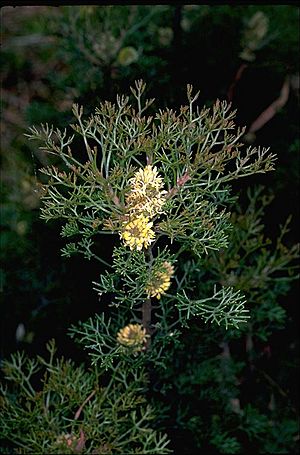Petrophile canescens facts for kids
Quick facts for kids Conesticks |
|
|---|---|
 |
|
| Petrophile canescens in the ANBG | |
| Scientific classification | |
| Genus: |
Petrophile
|
| Species: |
canescens
|
| Synonyms | |
|
|
Conesticks, also known as Petrophile canescens, is a cool flowering plant found only in eastern Australia. It's a type of shrub that stands upright and has unique leaves that look like feathers. Its flowers are white or pale cream and grow in fuzzy, oval-shaped clusters.
Contents
What Conesticks Look Like
Conesticks are upright shrubs that usually grow between 0.5 m (1 ft 8 in) and 3 m (9.8 ft) tall. When they are young, their branches and leaves are covered in soft, silky grey hairs.
Leaves and Flowers
The leaves are shaped like cylinders and can be 30 mm (1.2 in) to 110 mm (4.3 in) long. They grow on a stalk called a petiole, which is 20 mm (0.79 in) to 50 mm (2.0 in) long. These leaves are divided like a feather, with the main part being longer than the divided sections.
The flowers grow in oval-shaped clusters, often called heads, that are 10 mm (0.39 in) to 25 mm (0.98 in) long. Sometimes, you might see up to four of these heads grouped together. At the bottom of each flower head, there are small, hairy, triangular leaves called bracts.
The flowers themselves are 9 mm (0.35 in) to 12 mm (0.47 in) long and are white to a light cream color. They also feel silky and hairy.
When They Bloom
Conesticks usually bloom from September to January. After the flowers, the plant produces a type of fruit called a nut. These nuts are joined together in an oval or round head, which can be 15 mm (0.59 in) to 40 mm (1.6 in) long.
You can tell Conesticks apart from a similar plant called Petrophile pulchella because its new growth is covered in fine hairs.
How Conesticks Got Its Name
The scientific name for Conesticks, Petrophile canescens, was first officially written down in 1830. This was done by a botanist named Robert Brown. He used notes from another botanist, Allan Cunningham, who had described the plant earlier.
The second part of the name, canescens, is a Latin word. It means "becoming or being somewhat white or hoary," which describes the plant's appearance.
Where Conesticks Live
Conesticks grow in forests and sandy areas called heathlands. You can find them in the Blackdown Tableland in Queensland. They also grow south into New South Wales, reaching places like Nerriga and as far west as Warialda.

